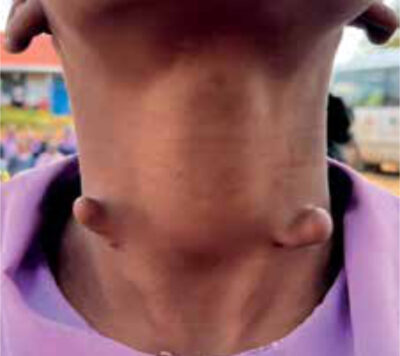Main content
The setting
This case report originates from St Luke’s Hospital, a rural mission hospital in Malosa, southern Malawi. The hospital possesses 175 beds with access to laboratory testing, ultrasound and X-ray imaging for diagnostics. The hospital provides a comprehensive HIV care program and serves as a referral hospital for several health centres in the region. These health centres provide basic primary healthcare with laboratory services limited to microscopy and rapid diagnostic tests. Additionally, they provide anti-retroviral therapy (ART) free of charge. The nearest third-line (governmental) hospital with an Intensive Care Unit is located 30 minutes from our hospital by private transport.
Case
A 40-year-old HIV-positive woman was referred to our hospital because of a reduced level of consciousness. Three days prior to referral, the patient went to her health centre because of jaundice, general body weakness and nausea lasting one week. There was no fever, abdominal pain, vomiting or decolorized stools. She was a non-smoker, and there was no history of herb or alcohol abuse.
Four months earlier, the patient tested positive for HIV and was immediately started on ART according to the local protocol: Tenofovir, Lamivudine and Efavirenz. As she had recently started HIV treatment, the medical assistant thought that the complaints could be side effects of ART, and the patient was advised to suspend the therapy.
On the day of referral, the woman was brought in to the health centre because her symptoms were progressive and she had lost consciousness. On admission in our hospital, the patient’s Glasgow Coma Scale was 6/15. The vital signs are summarized in Table 1. Despite severe jaundice, no other abnormalities were observed on physical examination. There was no wasting, neck stiffness, lymphadenopathy or oral thrush. The laboratory results are shown in Table 2. Abdominal ultrasound showed a shrunken, homogenous liver with some ascites. The gallbladder, bile ducts and spleen appeared normal.
The initial management consisted of broad spectrum antibiotics and intravenous fluids. After the laboratory results (Table 2) became available, suspicion of hepatic encephalopathy was raised. In the absence of other risk factors, i.e. negative Hepatitis B and C tests and non-dilatated bile ducts, toxic liver injury due to Efavirenz was strongly suspected and Prednisolone 1mg/ kg/day was started. Unfortunately, the patient deteriorated rapidly and she passed away only 36 hours after admission. Although the diagnosis of a severe adverse reaction to Efavirenz cannot be made with absolute certainty, it is the most likely cause of the severe hepatic injury in this case. Sadly, despite early recognition and adequate initial management by the health centre, the patient did not survive.
| Temperature | 37.5 C |
| Blood pressure | 95/55 mmHg |
| Pulse rate | 115 beats per minute |
| Saturation | 99% on room air |
Background of art induced liver injury
Antiretroviral drugs are increasingly available in less developed/low-resource countries and have a tremendous impact on life expectancy in HIV-infected people. However, ART may induce side effects, and hepatotoxicity is one of the most serious ones. Non-nucleoside reverse transcriptase inhibitors like Efavirenz are the most common cause of hepatotoxicity among ART subgroups. Most at risk are those treated with Nevirapine, those with pre-existent liver disease, and those who are treated with protease inhibitors as well. [1] In previously described case series, the onset of Efavirenz induced hepatotoxicity occurred between two and twenty-four weeks after initiation of treatment. [1-3] Although hepatotoxicity is usually mild and reversible after withdrawal of the Efavirenz, cases of Efavirenz induced fulminant liver failure have been described. [2,4,5] If patients with severe liver injury do not improve after interruption of Efavirenz, treatment with corticosteroids should be considered, although the evidence is limited and should be further investigated. [6,7]
| Normal values | ||
|---|---|---|
| Haemoglobin | 9.1 g/dL | (13.0-17.0 g/dL) |
| White blood cells | 13.7×10^9/L | (4.0-10.0×10^9) |
| Platelets | 389 x10^9/L | (100-300×10^9) |
| ALT | 141 U/L | (<34 U/L) |
| AST | 91 U/L | (<31 U/L) |
| GGT | 120 U/L | (6-45 U/L) |
| ALP | 1060 U/L | (64-306 U/L) |
| Conjugated bilirubin | 11.9 mg/dL | (<0.3 mg/dl) |
| Total bilirubin | 27.9 mg/dL | (<1.2 mg/dl) |
| Albumin | 2.7 g/L | (3.3-5.5 g/l) |
| Creatinine | 1.0 mg/dL | (0.5-1.1 mg/dl) |
| Urea | 17.0 mg/dL | (10-50 mg/dl) |
| Random blood sugar | 194 mg/dL | (60-133 mg/dl) |
| Hepatitis B/C | Negative | |
| Cryptococcal antigen test (serum) | Negative | |
| Malaria rapid diagnostic test | Negative |
In Malawi, Tenofovir/Lamivudine/Efavirenz is a first-line ART regimen and frequently the first choice when starting on ART. While starting ART is daily routine matter in every Malawian hospital, there are actually also major challenges involved as presented in our case. Although regular follow-up during the first months of therapy is recommended in the national protocol, laboratory resources are scarce and patient education regarding potential side effects is often limited. We presume that patients with ART induced liver injury are often missed and underreported. Increased awareness on the potential lethal side effects of ART and improved access to laboratory services can avoid unnecessary delay in changing the ART regimen, and this can save a patient’s life.
References
- Sulkowski MS, Thomas DL, Mehta SH, et al. Hepatotoxicity associated with Nevirapine or Efavirenz containing antiretroviral therapy: role of hepatitis C and B infections. Hepatology 2002;35(1):182-189.
- Segamwenge IL, Bernard MK. Acute Liver Failure among Patients on Efavirenz-based Antiretroviral Therapy. Case Reports Hepa-tol. 2018:1270716. Published 2018 May 10.
- Brück S, Witte S, Brust J et al. Hepatotoxic-ity in patients prescribed Efavirenz or Nevirap-ine. Eur J Med Res 2008;13(7):343-348.
- Fink DL, Bloch E. Liver transplantation for acute liver failure due to Efavirenz hepatotox-icity: the importance of routine monitoring. Int J HIV&AIDS 2013;24(10):831-833.
- Abrescia N, D’Abbraccio M, Figoni M, et al. Fulminant hepatic failure after the start of an Efavirenz-based HAART regimen in a treatment-naive female AIDS patient without hepatitis virus co-infection. J Antimicrob Chemother 2002;50(5):763-765.
- Bossi P, Colin D, Bricaire F, Caumes E. Hypersensi-tivity Syndrome Associated with Efavirenz Therapy. Clinical Infectious Diseases, 2000;1: 227-228.
- Czaja A. Drug-induced autoimmune-like hepa-titis. Dig Dis Sci. 2011;56:958-976.


















































